Abstract
Because treatment with lithium salts may impair renal concentrating ability, we investigated the possibility of a direct effect of lithium ions on the permeability to water of the collecting duct epithelium. The coefficient of hydraulic conductivity (Lp) of isolated perfused rabbit cortical collecting tubules (CCT) was measured in the presence and absence of arginine-8-vasopressin (AVP), or 8-bromo (Br) cyclic AMP (cAMP) and/or lithium chloride (Li 10 mM). In the absence of AVP, Li in the lumen for 30 min failed to affect basal water permeability; however, in tubules preincubated with Li in the lumen for 80 min, basal water permeability was reduced to 30% of the value found in control tubules (P less than 0.01). In CCT incubated at 25 degrees C with Li in the lumen for 3 h, the hydroosmotic response to 2.5 microU X ml-1 AVP (Lp = 6.88 +/- 1.54 nl X cm-2 X s-1 X atm-1) was significantly lower than that in the control tubules (13.98 +/- 1.59, P less than 0.01); the inhibition was not reversible. When Li was present in the peritubular medium only, the hydroosmotic effect of AVP was not different from that of the controls. The hydroosmotic effect of 25 microU/ml AVP was investigated at 37 degrees C. CCT exposed to Li in the lumen had a 49% inhibition of peak Lp under AVP (Lp = 10.98 +/- 1.17) as compared with control tubules (Lp = 21.39 +/- 1.51; P less than 0.005). In contrast, the hydroosmotic response to 8-Br-cAMP was not affected by lithium. The results are compatible with the view that Li inhibits the action of AVP at the level of the regulating protein or the catalytic unit of the membrane adenylate cyclase and that the site of the interaction can be reached by lithium only from the cytoplasmic side. The Li-antidiuretic hormone (ADH) interaction found here may represent the earliest pathophysiological event underlying the renal concentrating defect observed after Li administration.
Full text
PDF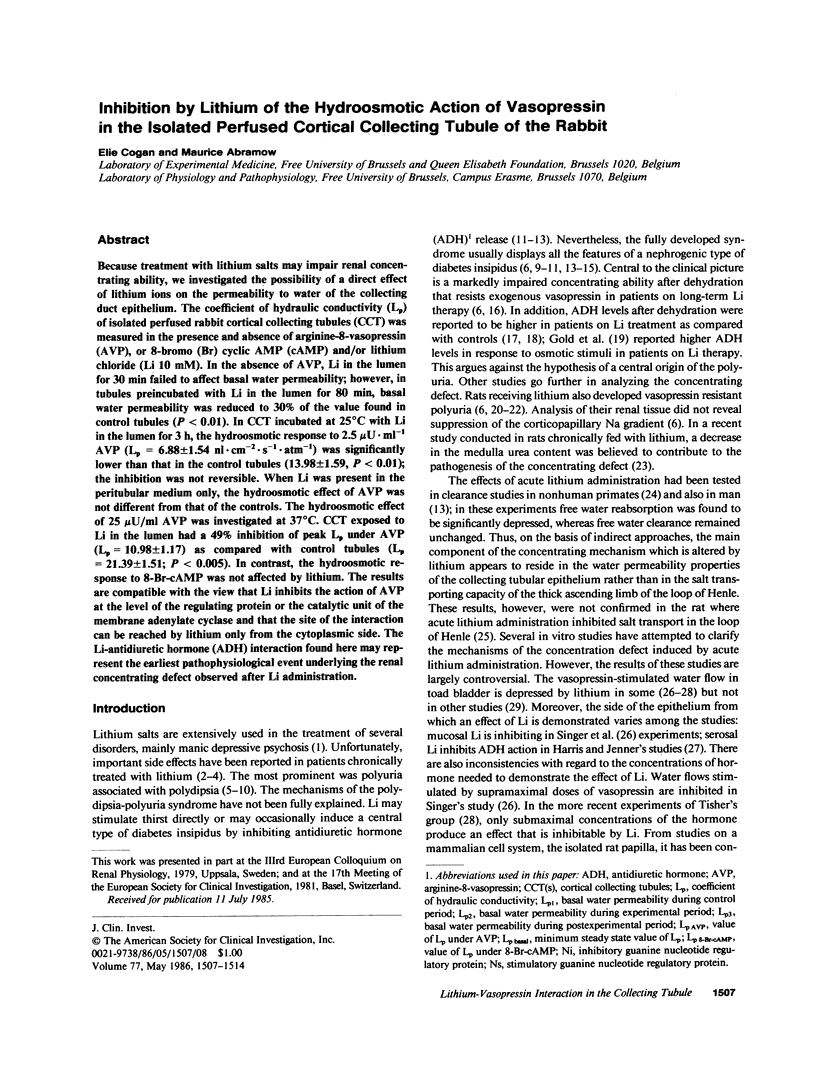
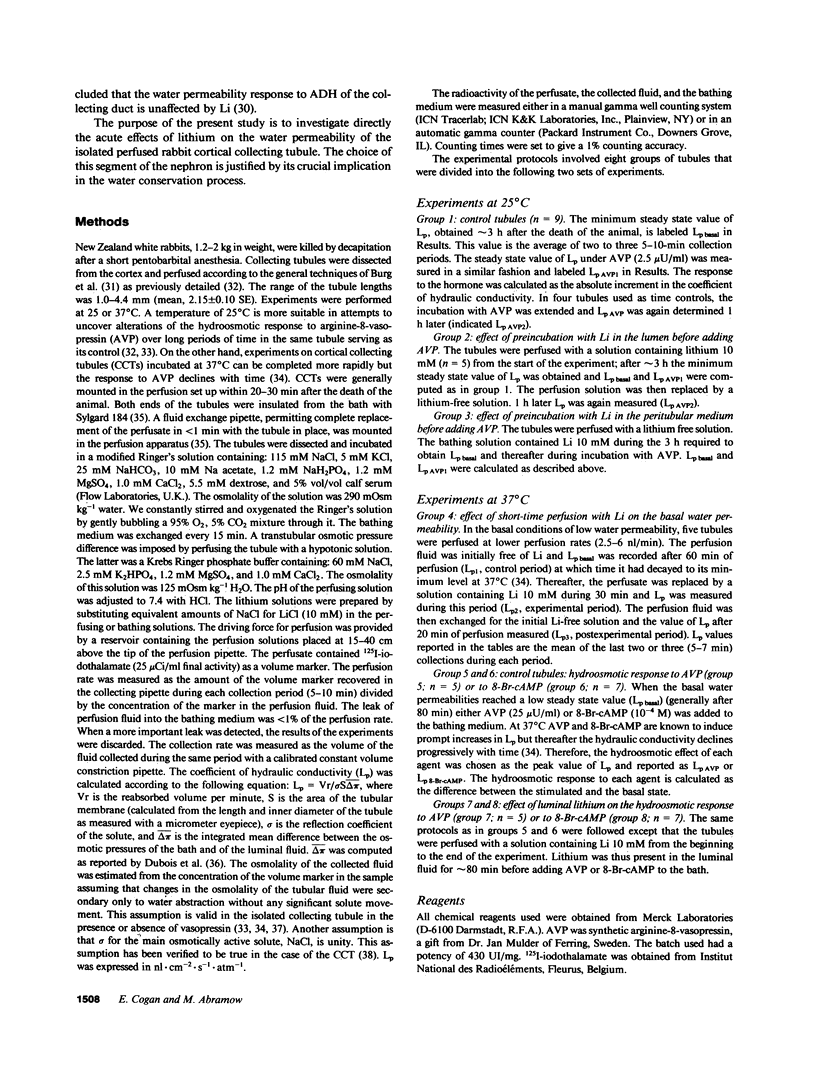
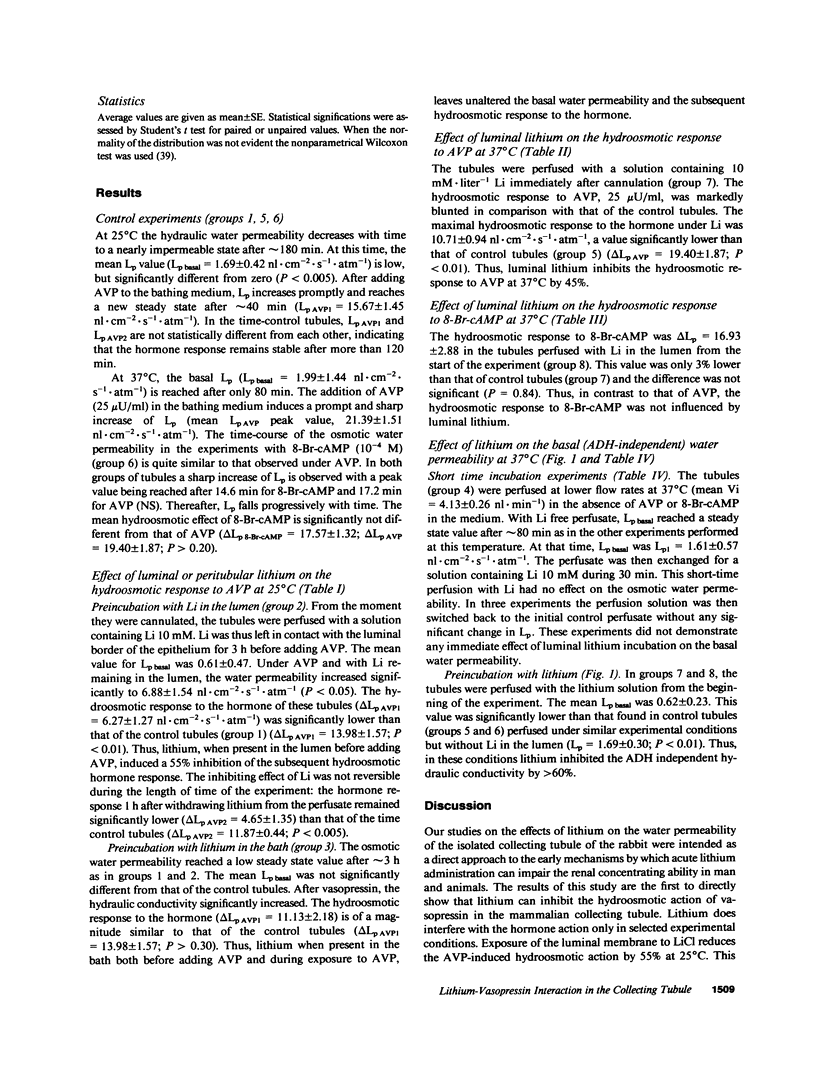
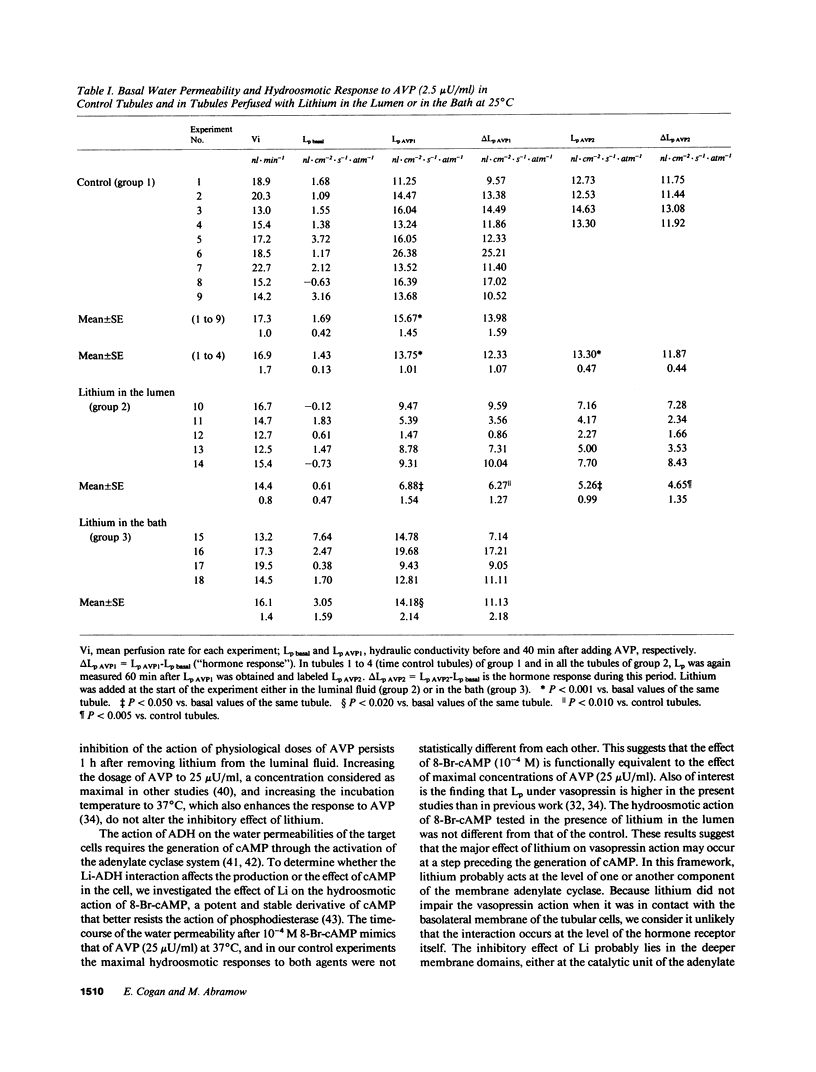
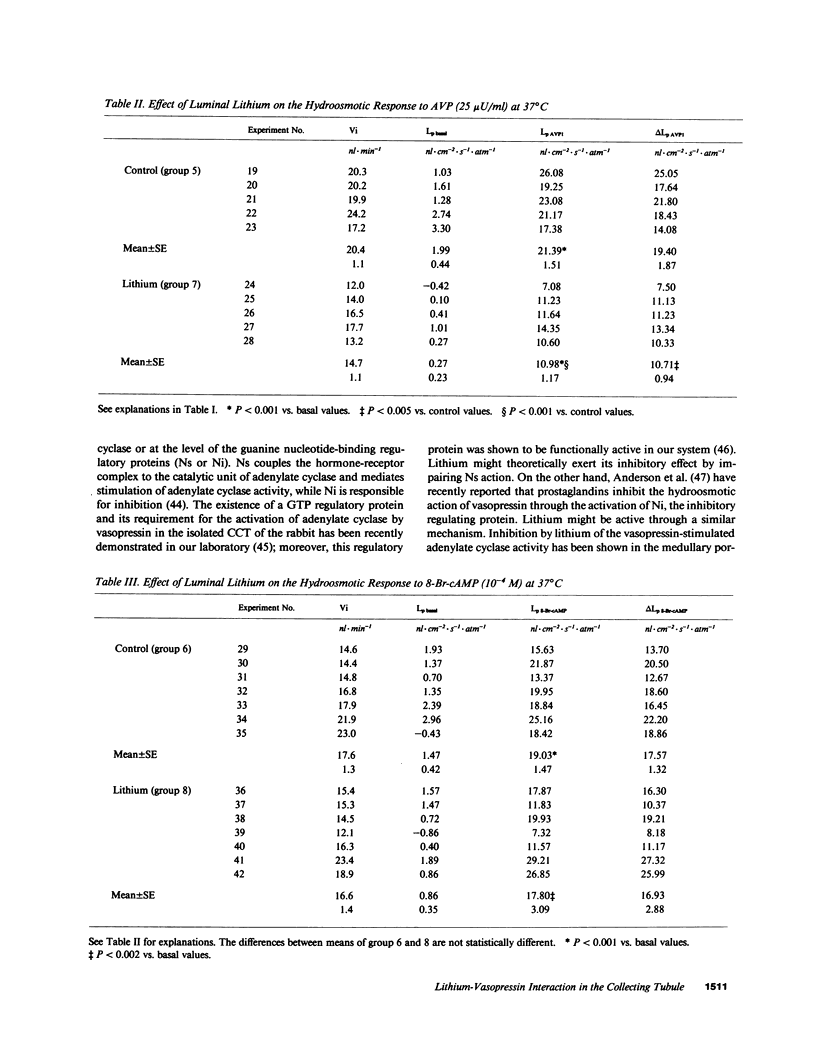
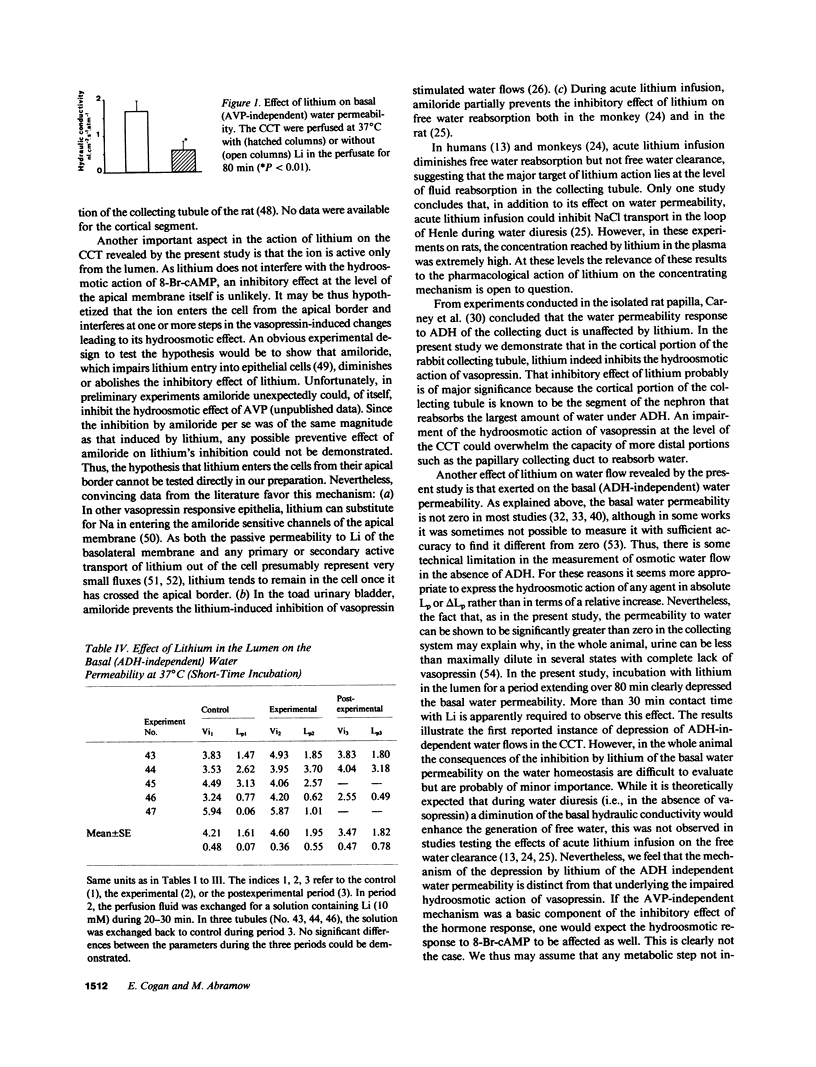
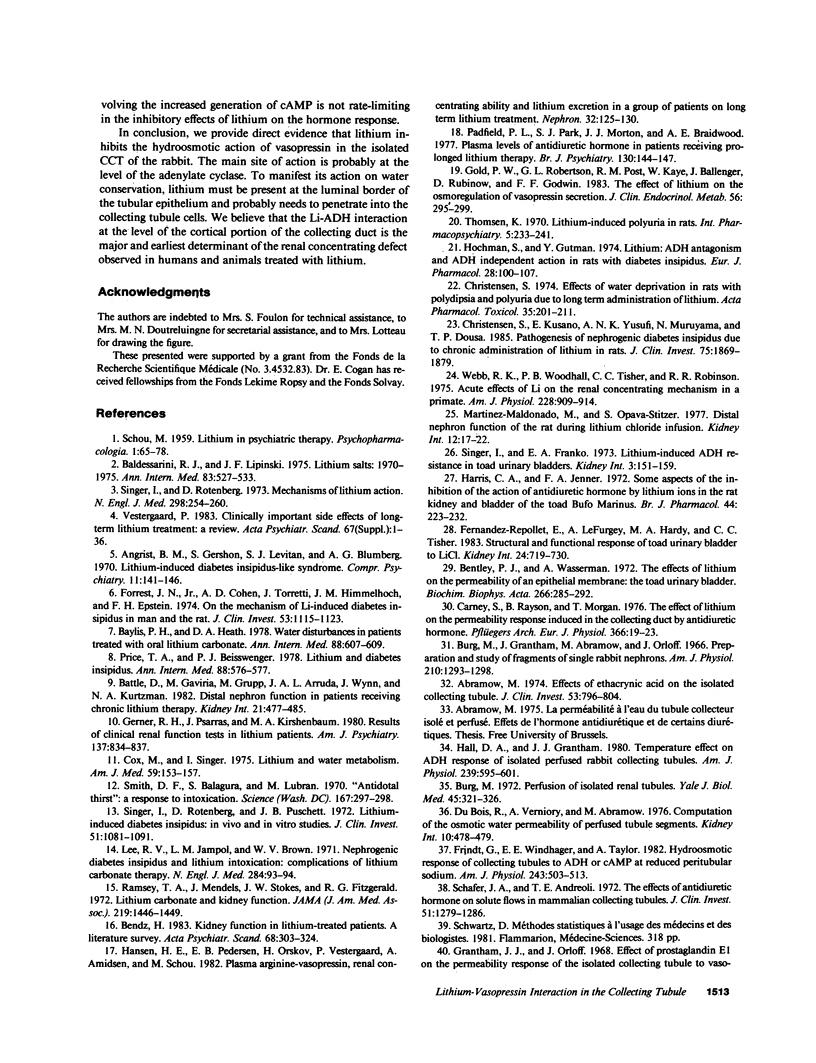
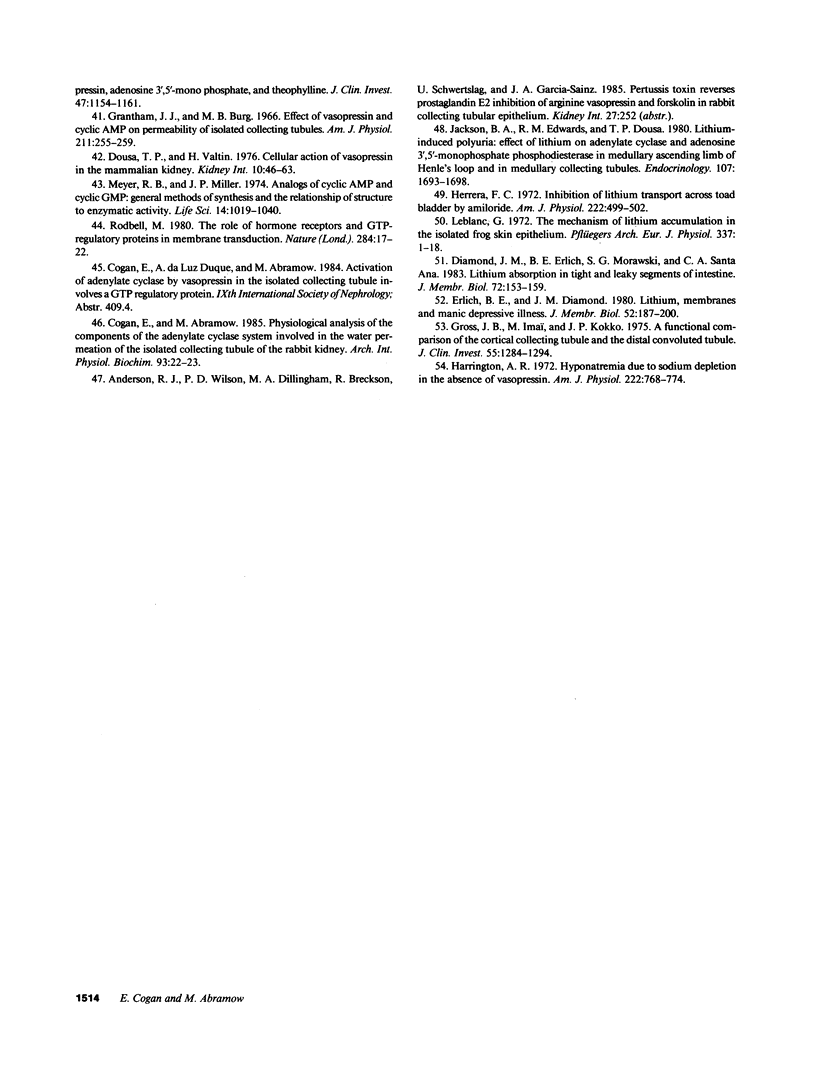
Selected References
These references are in PubMed. This may not be the complete list of references from this article.
- Abramow M. Effects of ethacrynic acid on the isolated collecting tubule. J Clin Invest. 1974 Mar;53(3):796–804. doi: 10.1172/JCI107618. [DOI] [PMC free article] [PubMed] [Google Scholar]
- Angrist B. M., Gershon S., Levitan S. J., Blumberg A. G. Lithium-induced diabetes insipidus-like syndrome. Compr Psychiatry. 1970 Mar;11(2):141–146. doi: 10.1016/0010-440x(70)90155-0. [DOI] [PubMed] [Google Scholar]
- Baldessarini R. J., Lipinski J. F. Lithium salts: 1970-1975. Ann Intern Med. 1975 Oct;83(4):527–533. doi: 10.7326/0003-4819-83-4-527. [DOI] [PubMed] [Google Scholar]
- Batlle D., Gaviria M., Grupp M., Arruda J. A., Wynn J., Kurtzman N. A. Distal nephron function in patients receiving chronic lithium therapy. Kidney Int. 1982 Mar;21(3):477–485. doi: 10.1038/ki.1982.49. [DOI] [PubMed] [Google Scholar]
- Baylis P. H., Heath D. A. Water disturbances in patients treated with oral lithium carbonate. Ann Intern Med. 1978 May;88(5):607–609. doi: 10.7326/0003-4819-88-5-607. [DOI] [PubMed] [Google Scholar]
- Bendz H. Kidney function in lithium-treated patients. A literature survey. Acta Psychiatr Scand. 1983 Nov;68(5):303–324. doi: 10.1111/j.1600-0447.1983.tb07012.x. [DOI] [PubMed] [Google Scholar]
- Bentley P. J., Wasserman A. The effects of lithium on the permeability of an epithelial membrane, the toad urinary bladder. Biochim Biophys Acta. 1972 Apr 14;266(1):285–292. doi: 10.1016/0005-2736(72)90143-5. [DOI] [PubMed] [Google Scholar]
- Burg M. B. Perfusion of isolated renal tubules. Yale J Biol Med. 1972 Jun-Aug;45(3-4):321–326. [PMC free article] [PubMed] [Google Scholar]
- Burg M., Grantham J., Abramow M., Orloff J. Preparation and study of fragments of single rabbit nephrons. Am J Physiol. 1966 Jun;210(6):1293–1298. doi: 10.1152/ajplegacy.1966.210.6.1293. [DOI] [PubMed] [Google Scholar]
- Carney S., Rayson B., Morgan T. The effect of lithium on the permeability response induced in the collecting duct by antidiuretic hormone. Pflugers Arch. 1976 Oct 15;366(1):19–23. [PubMed] [Google Scholar]
- Christensen S. Effects of water deprivation in rats with polydipsia and polyuria due to long-term administration of lithium. Acta Pharmacol Toxicol (Copenh) 1974 Sep;35(3):201–211. doi: 10.1111/j.1600-0773.1974.tb00740.x. [DOI] [PubMed] [Google Scholar]
- Christensen S., Kusano E., Yusufi A. N., Murayama N., Dousa T. P. Pathogenesis of nephrogenic diabetes insipidus due to chronic administration of lithium in rats. J Clin Invest. 1985 Jun;75(6):1869–1879. doi: 10.1172/JCI111901. [DOI] [PMC free article] [PubMed] [Google Scholar]
- Cox M., Singer I. Lithium and water metabolism. Am J Med. 1975 Aug;59(2):153–157. doi: 10.1016/0002-9343(75)90348-4. [DOI] [PubMed] [Google Scholar]
- Diamond J. M., Ehrlich B. E., Morawski S. G., Santa Ana C. A., Fordtran J. S. Lithium absorption in tight and leaky segments of intestine. J Membr Biol. 1983;72(1-2):153–159. doi: 10.1007/BF01870322. [DOI] [PubMed] [Google Scholar]
- Dousa T. P., Valtin H. Cellular actions of vasopressin in the mammalian kidney. Kidney Int. 1976 Jul;10(1):46–63. doi: 10.1038/ki.1976.78. [DOI] [PubMed] [Google Scholar]
- Du Bois R., Vernoiry A., Abramow M. Computation of the osmotic water permeability of perfused tubule segments. Kidney Int. 1976 Dec;10(6):478–479. doi: 10.1038/ki.1976.135. [DOI] [PubMed] [Google Scholar]
- Ehrlich B. E., Diamond J. M. Lithium, membranes, and manic-depressive illness. J Membr Biol. 1980;52(3):187–200. doi: 10.1007/BF01869189. [DOI] [PubMed] [Google Scholar]
- Fernandez-Repollet E., LeFurgey A., Hardy M. A., Tisher C. C. Structural and functional response of toad urinary bladder to LiCl. Kidney Int. 1983 Dec;24(6):719–730. doi: 10.1038/ki.1983.219. [DOI] [PubMed] [Google Scholar]
- Forrest J. N., Jr, Cohen A. D., Torretti J., Himmelhoch J. M., Epstein F. H. On the mechanism of lithium-induced diabetes insipidus in man and the rat. J Clin Invest. 1974 Apr;53(4):1115–1123. doi: 10.1172/JCI107649. [DOI] [PMC free article] [PubMed] [Google Scholar]
- Gerner R. H., Psarras J., Kirschenbaum M. A. Results of clinical renal function tests in lithium patients. Am J Psychiatry. 1980 Jul;137(7):834–837. doi: 10.1176/ajp.137.7.834. [DOI] [PubMed] [Google Scholar]
- Gold P. W., Robertson G. L., Post R. M., Kaye W., Ballenger J., Rubinow D., Goodwin F. K. The effect of lithium on the osmoregulation of arginine vasopressin secretion. J Clin Endocrinol Metab. 1983 Feb;56(2):295–299. doi: 10.1210/jcem-56-2-295. [DOI] [PubMed] [Google Scholar]
- Grantham J. J., Burg M. B. Effect of vasopressin and cyclic AMP on permeability of isolated collecting tubules. Am J Physiol. 1966 Jul;211(1):255–259. doi: 10.1152/ajplegacy.1966.211.1.255. [DOI] [PubMed] [Google Scholar]
- Grantham J. J., Orloff J. Effect of prostaglandin E1 on the permeability response of the isolated collecting tubule to vasopressin, adenosine 3',5'-monophosphate, and theophylline. J Clin Invest. 1968 May;47(5):1154–1161. doi: 10.1172/JCI105804. [DOI] [PMC free article] [PubMed] [Google Scholar]
- Gross J. B., Imai M., Kokko J. P. A functional comparison of the cortical collecting tubule and the distal convoluted tubule. J Clin Invest. 1975 Jun;55(6):1284–1294. doi: 10.1172/JCI108048. [DOI] [PMC free article] [PubMed] [Google Scholar]
- Hansen H. E., Pedersen E. B., Orskov H., Vestergaard P., Amdisen A., Schou M. Plasma arginine-vasopressin, renal-concentrating ability and lithium excretion in a group of patients on long-term lithium treatment. Nephron. 1982;32(2):125–130. doi: 10.1159/000182831. [DOI] [PubMed] [Google Scholar]
- Harrington A. R. Hyponatremia due to sodium depletion in the absence of vasopressin. Am J Physiol. 1972 Mar;222(3):768–774. doi: 10.1152/ajplegacy.1972.222.3.768. [DOI] [PubMed] [Google Scholar]
- Harris C. A., Jenner F. A. Some aspects of the inhibition of the action of antidiuretic hormone by lithium ions in the rat kidney and bladder of the toad Bufo marinus. Br J Pharmacol. 1972 Feb;44(2):223–232. [PMC free article] [PubMed] [Google Scholar]
- Herrera F. C. Inhibition of lithium transport across toad bladder by amiloride. Am J Physiol. 1972 Feb;222(2):499–502. doi: 10.1152/ajplegacy.1972.222.2.499. [DOI] [PubMed] [Google Scholar]
- Hochman S., Gutman Y. Lithium: ADH antagonism and ADH independent action in rats with diabetes insipidus. Eur J Pharmacol. 1974 Sep;28(1):100–107. doi: 10.1016/0014-2999(74)90118-6. [DOI] [PubMed] [Google Scholar]
- Jackson B. A., Edwards R. M., Dousa T. P. Lithium-induced polyuria: effect of lithium on adenylate cyclase and adenosine 3',5'-monophosphate phosphodiesterase in medullary ascending limb of Henle's loop and in medullary collecting tubules. Endocrinology. 1980 Dec;107(6):1693–1698. doi: 10.1210/endo-107-6-1693. [DOI] [PubMed] [Google Scholar]
- Leblanc G. The mechanism of lithium accumulation in the isolated frog skin epithelium. Pflugers Arch. 1972;337(1):1–18. doi: 10.1007/BF00587867. [DOI] [PubMed] [Google Scholar]
- Lee R. V., Jampol L. M., Brown W. V. Nephrogenic diabetes insipidus and lithium intoxication--complications of lithium carbonate therapy. N Engl J Med. 1971 Jan 14;284(2):93–94. doi: 10.1056/NEJM197101142840209. [DOI] [PubMed] [Google Scholar]
- Martinez-Maldonado M., Opava-Stitzer S. Distal nephron function of the rat during lithium chloride infusion. Kidney Int. 1977 Jul;12(1):17–22. doi: 10.1038/ki.1977.74. [DOI] [PubMed] [Google Scholar]
- Meyer R. B., Jr, Miller J. P. Analogs of cyclic AMP and cyclic GMP: general methods of synthesis and the relationship of structure to enzymic activity. Life Sci. 1974 Mar 16;14(6):1019–1040. doi: 10.1016/0024-3205(74)90228-8. [DOI] [PubMed] [Google Scholar]
- Padfield P. L., Park S. J., Morton J. J., Braidwood A. E. Plasma levels of antidiuretic hormone in patients receiving prolonged lithium therapy. Br J Psychiatry. 1977 Feb;130:144–147. doi: 10.1192/bjp.130.2.144. [DOI] [PubMed] [Google Scholar]
- Price T. R., Beisswenger P. J. Lithium and diabetes insipidus. Ann Intern Med. 1978 Apr;88(4):576–577. doi: 10.7326/0003-4819-88-4-576_2. [DOI] [PubMed] [Google Scholar]
- Ramsey T. A., Mendels J., Stokes J. W., Fitzgerald R. G. Lithium carbonate and kidney function. A failure in renal concentrating ability. JAMA. 1972 Mar 13;219(11):1446–1449. [PubMed] [Google Scholar]
- Rodbell M. The role of hormone receptors and GTP-regulatory proteins in membrane transduction. Nature. 1980 Mar 6;284(5751):17–22. doi: 10.1038/284017a0. [DOI] [PubMed] [Google Scholar]
- SCHOU M. Lithium in psychiatric therapy. Stock-taking after ten years. Psychopharmacologia. 1959;1:65–78. doi: 10.1007/BF00408113. [DOI] [PubMed] [Google Scholar]
- Schafer J. A., Andreoli T. E. The effect of antidiuretic hormone on solute flows in mammalian collecting tubules. J Clin Invest. 1972 May;51(5):1279–1286. doi: 10.1172/JCI106922. [DOI] [PMC free article] [PubMed] [Google Scholar]
- Singer I., Franko E. A. Lithium-induced ADH resistance in toad urinary bladders. Kidney Int. 1973 Mar;3(3):151–159. doi: 10.1038/ki.1973.23. [DOI] [PubMed] [Google Scholar]
- Singer I., Rotenberg D. Mechanisms of lithium action. N Engl J Med. 1973 Aug 2;289(5):254–260. doi: 10.1056/NEJM197308022890508. [DOI] [PubMed] [Google Scholar]
- Singer I., Rotenberg D., Puschett J. B. Lithium-induced nephrogenic diabetes insipidus: in vivo and in vitro studies. J Clin Invest. 1972 May;51(5):1081–1091. doi: 10.1172/JCI106900. [DOI] [PMC free article] [PubMed] [Google Scholar]
- Smith D. F., Balagura S., Lubran M. "Antidotal thirst": a response to intoxication. Science. 1970 Jan 16;167(3916):297–298. doi: 10.1126/science.167.3916.297. [DOI] [PubMed] [Google Scholar]
- Vestergaard P. Clinically important side effects of long-term lithium treatment: a review. Acta Psychiatr Scand Suppl. 1983;305:1–36. [PubMed] [Google Scholar]
- Webb R. K., Woodhall P. B., Tisher C. C., Robinson R. R. Acute effects of lithium on the renal concentrating mechanism in a primate. Am J Physiol. 1975 Mar;228(3):909–914. doi: 10.1152/ajplegacy.1975.228.3.909. [DOI] [PubMed] [Google Scholar]


